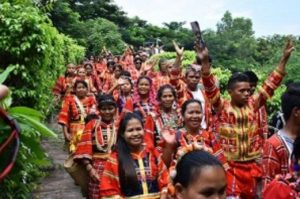FREE FLOW OF INFORMATION
An article by Gail Ilagan for Minda News
Republic Act No. 10908 was signed into law on 21 July 2016, mandating the integration of Filipino-Muslim and Indigenous Peoples history, culture and identity in the study of Philippine History in both Basic and Higher Education. The law recognizes the ultimate objective of creating an inclusive history that accounts for all Filipinos, thus the need to integrate the history, culture and identity studies of Filipino-Muslims and Indigenous People in the grand narrative of Philippine history.

(Click on photo to enlarge)
Earlier in March 2016, the Transitional Justice and Reconciliation Commission (TJRC) released its main report and recommended among others to “integrate in the curricula at all educational levels… subjects on Bangsamoro history, indigenous peoples’ history, and corresponding lessons in art, literature, and language by promoting intercultural exchange and cultural diversity.”
There is however a dearth of resources on Bangsamoro and Lumad history, art, literature, and language. Many Philippine History textbooks for Basic Education are largely silent, misrepresentative, confused, or vague on these topics. Teachers have been known to decry that they don’t know what to teach about Mindanao and its peoples and that they haven’t been given authoritative sources on Mindanao history. There is a need, therefore, to generate educational materials that Basic Education teachers of Philippine History can use in the implementation of RA 10908.
The Mindanao-Sulu History and Peace Education Project seeks to respond to this need. Funded by the World Bank and implemented through the Catholic Education Association of the Philippines (CEAP), the project was conceived by Fr. Albert E. Alejo, SJ, one of the staunchest advocates for the Writing Mindanao, Righting Mindanao campaign.
(Article continued in right column)
Can peace be achieved in Mindanao?
(Article continued from left column)
For this project, however, writing about Mindanao was not about turning out lengthy expositions, such as were attempted in the past. The Timeline project sought instead to introduce Mindanao through bite-size pieces intended to raise initial interest. It used no more than 50-word blurbs crafted by professional writers to introduce political, economic, cultural, and ecological events identified by reputable academics such as Patricio Abinales, Macario Tiu, and Karl Gaspar to be highlights in Mindanao history.
These blurbs, accompanied by pictures from the MindaNews archives, were laid out in an infographic that could theoretically be mounted on the classroom wall and referred to during history classes. The infographic, printed on tarpaulin, does not require an LCD player – thus it has particular utility in schools where there is no electricity.
Towards the end of 2016, the infographic was reviewed by the National Historical Institute, the National Commission on Indigenous Peoples, the Office of Muslim Affairs and, more recently, by the Jesuit Basic Education Council. At each stop in the review process, more items of interest were added, such that the final product consists of 211 items plotted on a 7-meter stretch of canvas.
In March 2017, a full year after the Mindanao Timeline project was conceived, the Department of Education and the CEAP invited Basic Education teachers in Regions V, VII, and IX to pilot workshops on the utility of the tarp as instructional resource. Project Manager Pauline S. Bautista put together a multi-disciplinary team – consisting of Pauline, Fr. Alejo,Bagong Lumad artist Joey Ayala, ADDU Psychology Department chair Dr. Nelly Limbadan, and myself – to deliver on a design that introduced the timeline in a fun and interactive manner.
Dr. Limbadan designed the tools to measure the cognitive reframing impact of the infographic workshop on the participants. The results indicate that the material did indeed expand the associations the participants now have of Mindanao and its people and generated the interest to visit the southern islands to learn more about it. Moreover, the participants were now more ready to account for a sense of multicultural awareness in the way they would handle instruction on Mindanao history in the future.
Every school that was represented in the pilot will receive a copy of the final Timeline tarp accompanied by a bound compilation with a page dedicated to each item on the infographic. It is hoped that Philippine History teachers in grade school and high school would use these materials to complement the textbooks they are using.
(Thank you to the Peace Education News for sending us this article)